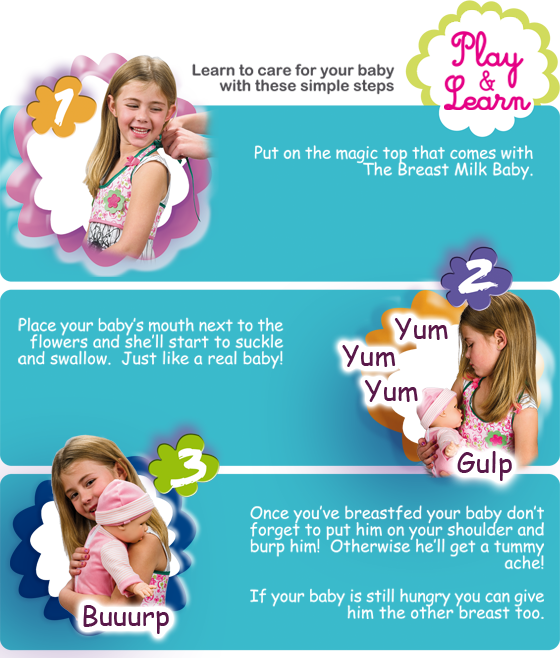A baby doll for learning about breastfeeding can be seen as either innovative or creepy.
I’m a fan of breastfeeding. I think it’s rolled up with the other gender-based issues in our society. Toy stores and many parents groom girls to be perfect little mommies by creating every type of doll imaginable, but then society says “eww” when Mom tries to feed her child naturally. Breastfeeding is a natural and necessary part of life. Yes, there are formula and pumps, but sometimes a kid is hungry and all you have is what’s on you. Literally. And yet we hide it. We avert our eyes when we see it, mothers wrestle with nursing blankets to hide it, and people make hurtful and inappropriate jokes about it. A woman recently returned from maternity leave came into work with a damp mark over her breast (having experienced a leak) only for a coworker to ask, “Anybody thirsty?” Wow.
Finally though, breastfeeding is saved from social damnation by The Breast Milk Baby! ¬†It’s a baby that makes suckling noises when a little girl dons a flowery halter top with sensors in place of nipples and holds the doll up to her pre-pubescent chest. There’s even fussing and burping involved. There’s also the usual array of responses: positive (because it promotes breastfeeding), pro-idea but anti-doll, and against because it’s creepy/gross/sexualizing children.
My gut reaction is “eww.” I don’t like that the sensors on the halter top are emphasized to make the floral nipples stand out. Granted, there’s no breastfeeding without nipples, but this mimics nipples while still shaming them. That said, I certainly don’t want a halter top with realistic nipples.
Mom and blogger Theresa Walsh Giarrusso addresses this doll, saying that, ultimately, she’s for it because it promotes girls learning about nursing and increases the probability they will do it for their own children someday. But she ends with the point that, in my opinion, makes the doll entirely moot: “I think kids can play nurse with a regular doll too and pretend the baby is suckling. I remember Rose play nursing probably because she was seeing me nurse Walsh all the time!…I loved seeing her do that.”
That’s just it: toys are often for learning through play, imitating life without recreating it. Advancing technology is blurring the lines, though. Perhaps I’m just sad that this toy has a great message but contributes to the obsolescence of imagination. It could also be counter-productive, as parents might feel compelled to prohibit the doll from social activities where other dolls would be acceptable. But perhaps this doll SHOULD be acceptable alongside other dolls.
I found other toys that address breast-feeding, and even more intense stuff like vaginal and cesarean births, by MamAmor. I think I like them better. They educate children about the realities of birth and child-rearing (placenta included!) in a way that doesn’t get involved with the sexual maturity of the child. There’s a time and a place for girls to make the connection between their own bodies and the biological details of “where babies come from,” and while I won’t comment on when and where that is, the MamAmor dolls make defining that method fun, interesting, beautiful, and flexible. A Vaginal Birth After Cesarean (VBAC) doll is a great example. It takes a real, often dangerous situation and crafts it into a beautiful doll that allows children to learn about the whats and hows of birth–and even breastfeeding (sans sound effects)–in a safe way and non-scary way (unlike my introduction to cesareans on The Learning Channel). Ultimately, you have girls that learn about their bodies and motherhood in stages, getting to high school health class without confusion. I think that’s safer for everyone.
I think the MamAmor dolls are a better idea than strapping on flower nipples and listening to a robot suckle. If a girl wants to play nursing, let her play–with her own imagination. And if she wants to pretend to nurse in public, that’s fine, too. If she wants a doll with a cesarean scar like her mother’s, that’s great because she can begin learning about physical realities. Either way, and with either toy, there needs to be parental guidance in explaining what’s happening and why. I love the idea of little girls knowing their own bodies and how they will change as they grow up; at age three I happily told my grandmother I would have my own baby one day and it would come out of my vagina…she wasn’t thrilled, but at least I knew the reality. But I don’t like the idea of technological advances replacing good parenting, creativity, and imagination in tackling life’s lessons.
-K. Sarah Ostrach
Junior Girl
Girl Museum Inc.

